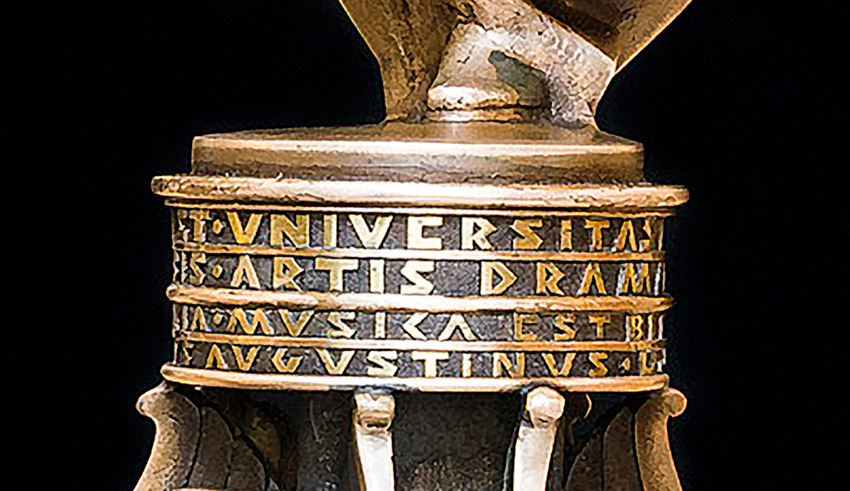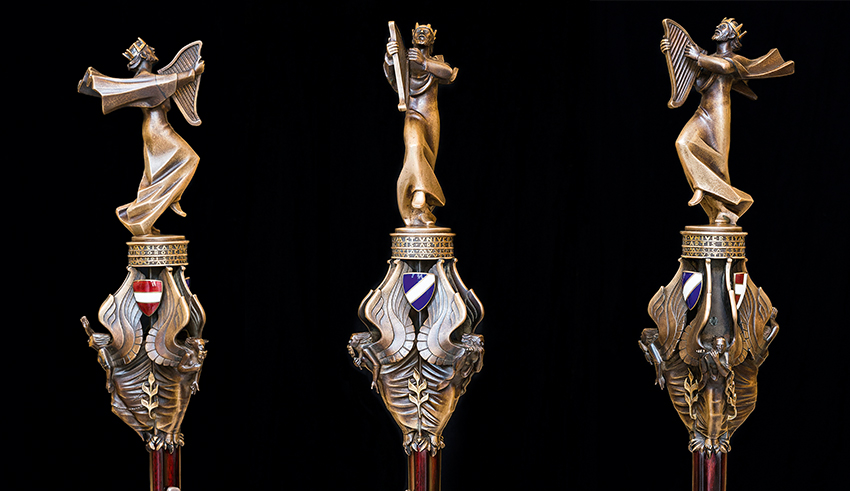Ein Gespräch mit Altrektor Gottfried Scholz
Die AbsolventInnen der mdw versprechen im Rahmen ihrer Sponsion und Promotion mit den Worten „Ich gelobe!“ ihrer Universität auf Dauer verbunden zu bleiben, wobei sie das Zepter der mdw berühren. An die Anfänge dieser Zeremonie und des Zepters erinnert sich Altrektor Gottfried Scholz im Gespräch mit Vizerektor Christian Meyer.

Christian Meyer (CM): Herr Professor Scholz, im Rahmen einer Feier übergaben Sie vor einigen Monaten das Bronze-Modell eines tanzenden, singenden und die Laute spielenden Königs David an Rektorin Ulrike Sych. Er führt all jene Künste aus, die an unserer Universität gelehrt werden. Das Original dieser Figur schmückt heute das Zepter der mdw.
Gottfried Scholz (GS): Der Entwurf des Königs David stammt vom ehemaligen Rektor der heutigen Akademie der bildenden Künste Wien, Professor Ferdinand Welz (1915–2008). Ab 1982 bot die damalige Hochschule für Musik und darstellende Kunst Wien ein Doktoratsstudium an. Eine Voraussetzung dafür war, dass wir ernsthafte Promotionsstudien ermöglichten, was wir zunächst auch durch die Einbindung von Ordinarien der Universität Wien etwa aus den Fächern Psychologie, Germanistik, Romanistik oder Musikwissenschaft als Zweitbegutachter sicherstellten. Die erste Dissertantin arbeitete bei mir zum psychologischen Hintergrund der Oper Wozzeck von Alban Berg; anlässlich ihrer Promotion im April 1985 kam das Zepter erstmals bei einer Promotion zum Einsatz.
CM: Gab es Widerstand gegen die Einführung des Doktoratsstudiums an der mdw?
GS: Lehrende der Universität Wien befürchteten, dass wir das Doktorat billig vergeben würden aufgrund einfacher Rigorosen, ohne schriftliche Arbeit und ohne Zeremonie. Dies war infolge der 68er-Bewegung an einigen deutschen Universitäten gemacht worden oder an der Universität Florenz, deren Studentenschaft kurzfristig das Rektorat übernommen hatte. Wir konnten die Seriosität unserer Absichten glaubhaft versichern. Als weitere Voraussetzung sahen wir die Notwendigkeit, unsere Promotionen in würdigem Rahmen nach Vorbild der Universität Wien abzuhalten. Dafür benötigten wir auch ein Zepter.

CM: Professor Welz hatte das Edelweiß der 1-Schilling-Münze und die Frau mit Goldhaube der 10-Schilling-Münze entworfen, ebenso eine Gedenkmünze anlässlich des 100. Geburtstags von Max Reinhardt. Prädestinierten ihn sein Ruf als Bildhauer und Graveur sowie diese Referenzen für die gestellte Aufgabe?
GS: Die Idee des Königs David stammt von ihm. Seinen Kostenvoranschlag beantragten wir wie üblich beim Ministerium, doch der zuständige Ministerialrat sah sich nicht in der Lage, für das ungewöhnliche Anliegen eine Zustimmung zu erteilen. – „Das geht nach oben!“ Nachdem auch der Sektionschef die Verantwortung nicht übernehmen wollte, musste ich das Anliegen Wissenschaftsministerin Hertha Firnberg persönlich vorstellen. Sie ließ sich das Konzept des Königs David präsentieren, in einem weiteren Termin besuchten wir Professor Welz gemeinsam in seinem Atelier an der Bildenden. Das Modell überzeugte schließlich die Ministerin, und wir konnten den Auftrag erteilen. Für solche Dinge nahmen sich die MinisterInnen damals Zeit!
CM: Die Schriftbänder unterhalb der Skulptur enthalten die Sätze: UNIVERSITAS RERUM MUSICARUM ET ARTIS DRAMATICAE VINDOBONENSIS sowie MUSICA EST BENE MODULANDI SCIENTIA (Musik ist das Wissen um die rechte Gestaltung). Bemerkenswert ist die Bezeichnung der mdw als „Universität“, zumal diese noch für mehr als zwei Jahrzehnte eine Hochschule war und erst 1998 zur Universität aufstieg.
GS: Ich bat unseren Professor Friedrich Heller um einen Spruch, der kurz sein und die Musik und darstellende Kunst einschließen musste. Nach einigen Tagen fand er dieses lateinische Zitat aus De musica von Augustinus. Auch die Sponsionsformel verlasen wir in der ersten Zeit noch auf Lateinisch, die AbsolventInnen und PromovendInnen antworteten: „Spondeo ac polliceor.“
CM: Woher kam der Entwurf, den Sie nun übergeben haben?
GS: Den fertigte Welz als Modell zur Veranschaulichung an, und nachdem er seinen Zweck erfüllt hatte, überließ er ihn mir. Mehr als 30 Jahre schmückte er meinen Schreibtisch, aber letztendlich gehört er doch an die Universität in das Büro der Rektorin, und ich bin glücklich, dass Rektorin Ulrike Sych die Skulptur gerne übernommen hat.

